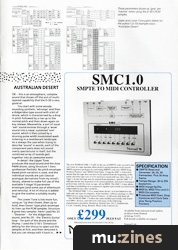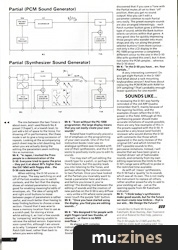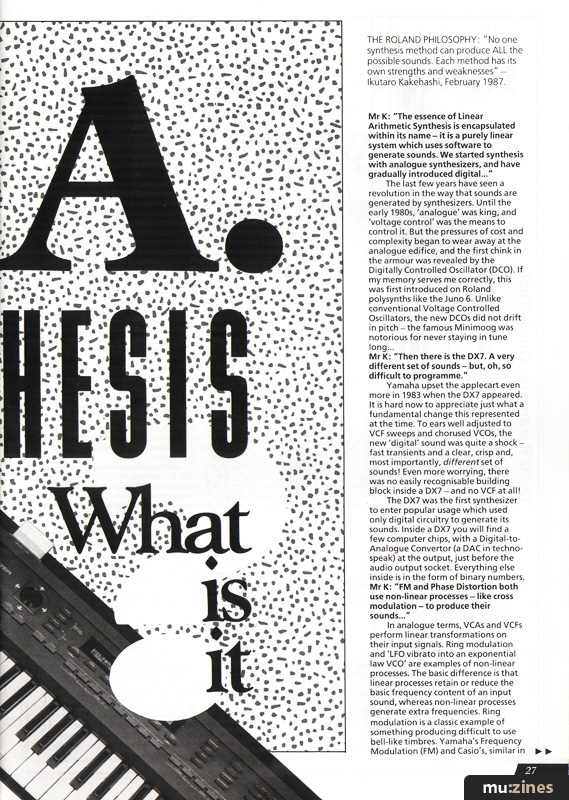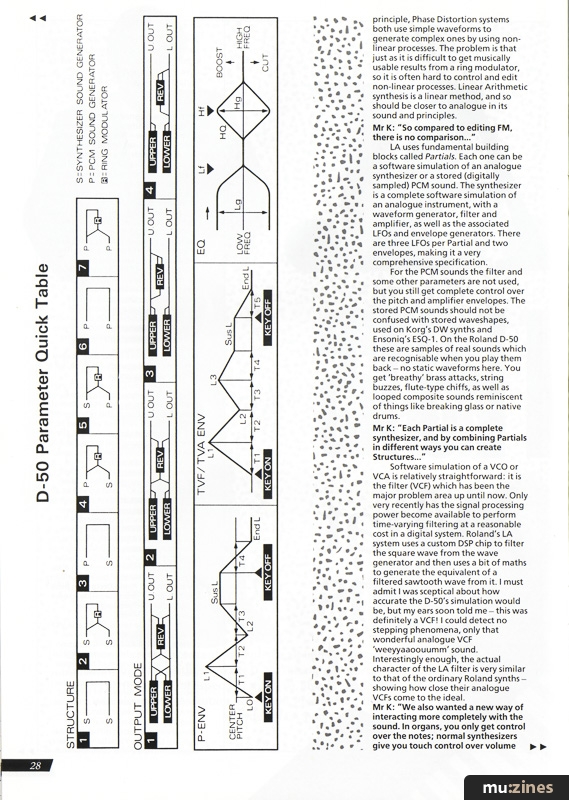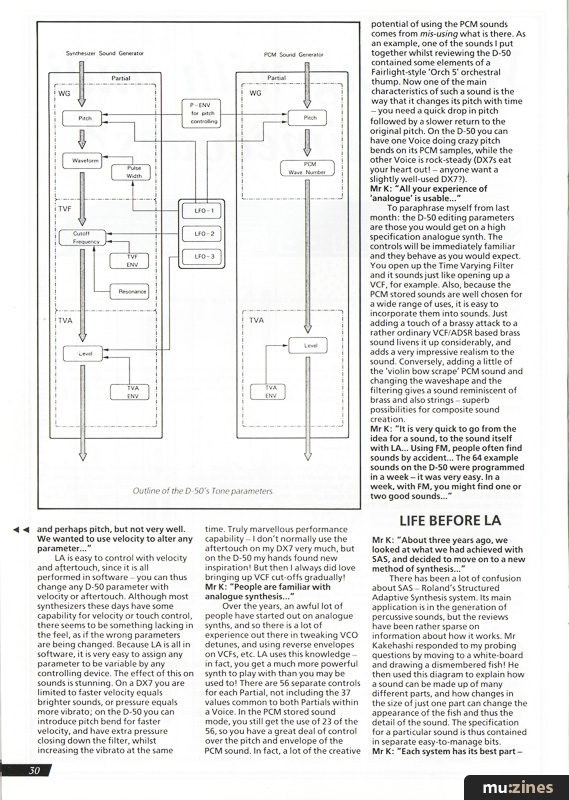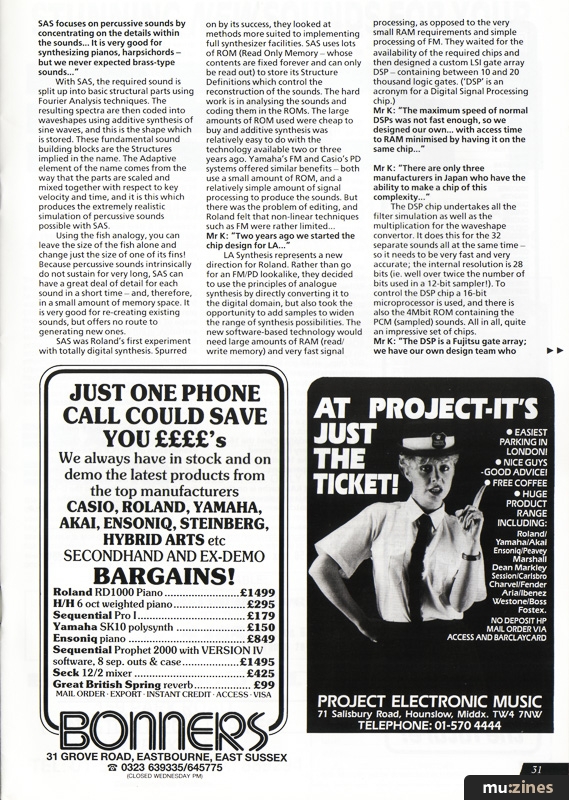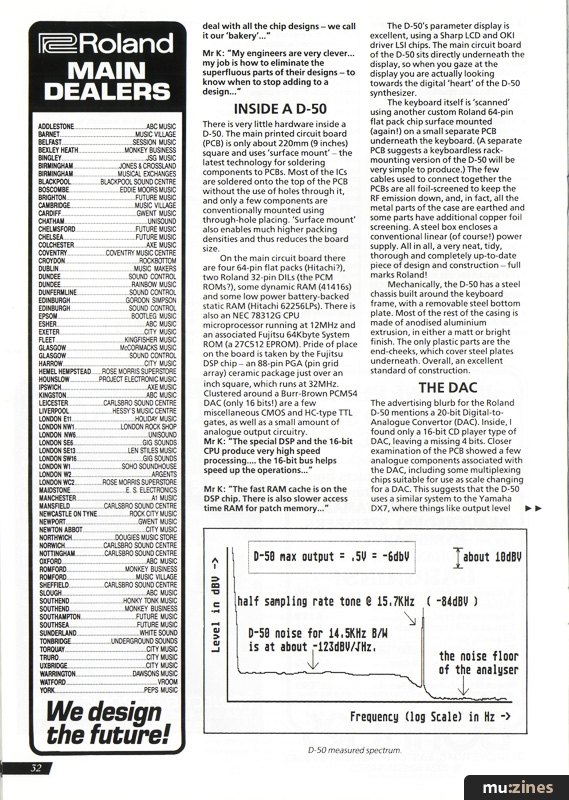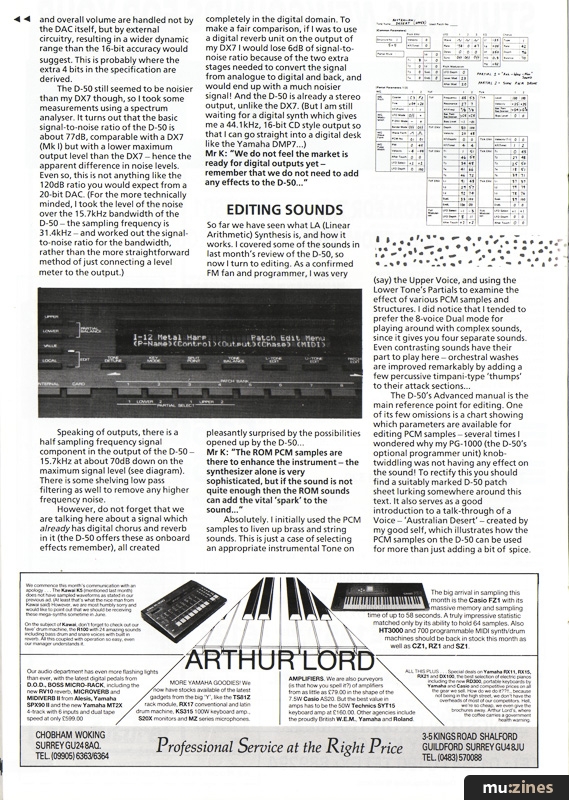Magazine Archive
Home -> Magazines -> Issues -> Articles in this issue -> View
L.A. Synthesis: What Is It? (Part 2) | |
Ikutaro KakehashiArticle from Sound On Sound, June 1987 | |
Continuing on from last month's review of the Roland D-50 Linear Arithmetic synthesizer, Martin Russ takes a detailed look at the technical aspects of the D-50, liberally sprinkled with excerpts from a rare interview with Mr Ikutaro Kakehashi, President of the Roland Corporation.
Last month's review concentrated on the all-important sounds of Roland's first ever Linear Arithmetic synthesizer, the D-50. This month Martin Russ presents a detailed report on the technical aspects of the D-50, liberally sprinkled with excerpts from a rare interview with Mr Ikutaro Kakehashi, President of the Roland Corporation and inventor of LA Synthesis.

THE ROLAND PHILOSOPHY: "No one synthesis method can produce ALL the possible sounds. Each method has its own strengths and weaknesses"
- Ikutaro Kakehashi, February 1987.
Mr K: "The essence of Linear Arithmetic Synthesis is encapsulated within its name - it is a purely linear system which uses software to generate sounds. We started synthesis with analogue synthesizers, and have gradually introduced digital..."
The last few years have seen a revolution in the way that sounds are generated by synthesizers. Until the early 1980s, 'analogue' was king, and 'voltage control' was the means to control it. But the pressures of cost and complexity began to wear away at the analogue edifice, and the first chink in the armour was revealed by the Digitally Controlled Oscillator (DCO). If my memory serves me correctly, this was first introduced on Roland polysynths like the Juno 6. Unlike conventional Voltage Controlled Oscillators, the new DCOs did not drift in pitch - the famous Minimoog was notorious for never staying in tune long...
Mr K: "Then there is the DX7. A very different set of sounds - but, oh, so difficult to programme."
Yamaha upset the applecart even more in 1983 when the DX7 appeared. It is hard now to appreciate just what a fundamental change this represented at the time. To ears well adjusted to VCF sweeps and chorused VCOs, the new 'digital' sound was quite a shock - fast transients and a clear, crisp and, most importantly, different set of sounds! Even more worrying, there was no easily recognisable building block inside a DX7 - and no VCF at all!
The DX7 was the first synthesizer to enter popular usage which used only digital circuitry to generate its sounds. Inside a DX7 you will find a few computer chips, with a Digital-to-Analogue Convertor (a DAC in technospeak) at the output, just before the audio output socket. Everything else inside is in the form of binary numbers.
Mr K: "FM and Phase Distortion both use non-linear processes - like cross modulation - to produce their sounds..."
In analogue terms, VCAs and VCFs perform linear transformations on their input signals. Ring modulation and 'LFO vibrato into an exponential law VCO' are examples of non-linear processes. The basic difference is that linear processes retain or reduce the basic frequency content of an input sound, whereas non-linear processes generate extra frequencies. Ring modulation is a classic example of something producing difficult to use bell-like timbres. Yamaha's Frequency Modulation (FM) and Casio's, similar in principle, Phase Distortion systems both use simple waveforms to generate complex ones by using non-linear processes. The problem is that just as it is difficult to get musically usable results from a ring modulator, so it is often hard to control and edit non-linear processes. Linear Arithmetic synthesis is a linear method, and so should be closer to analogue in its sound and principles.
Mr K: "So compared to editing FM, there is no comparison..."
LA uses fundamental building blocks called Partials. Each one can be a software simulation of an analogue synthesizer or a stored (digitally sampled) PCM sound. The synthesizer is a complete software simulation of an analogue instrument, with a waveform generator, filter and amplifier, as well as the associated LFOs and envelope generators. There are three LFOs per Partial and two envelopes, making it a very comprehensive specification.
For the PCM sounds the filter and some other parameters are not used, but you still get complete control over the pitch and amplifier envelopes. The stored PCM sounds should not be confused with stored waveshapes, used on Korg's DW synths and Ensoniq's ESQ-1. On the Roland D-50 these are samples of real sounds which are recognisable when you play them back - no static waveforms here. You get 'breathy' brass attacks, string buzzes, flute-type chiffs, as well as looped composite sounds reminiscent of things like breaking glass or native drums.
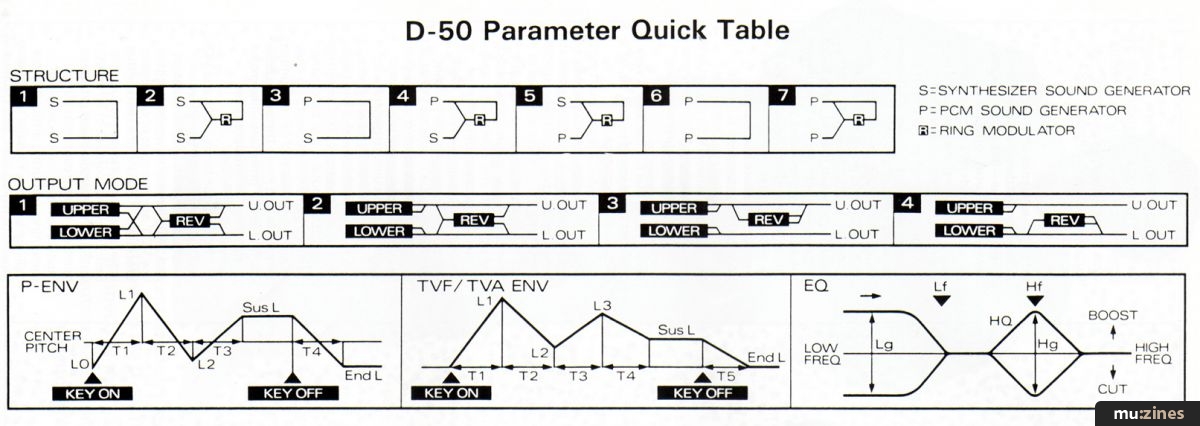
D-50 Parameter Quick Table
Mr K: "Each Partial is a complete synthesizer, and by combining Partials in different ways you can create Structures..."
Software simulation of a VCO or VCA is relatively straightforward: it is the filter (VCF) which has been the major problem area up until now. Only very recently has the signal processing power become available to perform time-varying filtering at a reasonable cost in a digital system. Roland's LA system uses a custom DSP chip to filter the square wave from the wave generator and then uses a bit of maths to generate the equivalent of a filtered sawtooth wave from it. I must admit I was sceptical about how accurate the D-50's simulation would be, but my ears soon told me - this was definitely a VCF! I could detect no stepping phenomena, only that wonderful analogue VCF 'weeyyaaoouumm' sound.
Interestingly enough, the actual character of the LA filter is very similar to that of the ordinary Roland synths - showing how close their analogue VCFs come to the ideal.
Mr K: "We also wanted a new way of interacting more completely with the sound. In organs, you only get control over the notes; normal synthesizers give you touch control over volume and perhaps pitch, but not very well. We wanted to use velocity to alter any parameter..."
LA is easy to control with velocity and aftertouch, since it is all performed in software - you can thus change any D-50 parameter with velocity or aftertouch. Although most synthesizers these days have some capability for velocity or touch control, there seems to be something lacking in the feel, as if the wrong parameters are being changed. Because LA is all in software, it is very easy to assign any parameter to be variable by any controlling device. The effect of this on sounds is stunning. On a DX7 you are limited to faster velocity equals brighter sounds, or pressure equals more vibrato; on the D-50 you can introduce pitch bend for faster velocity, and have extra pressure closing down the filter, whilst increasing the vibrato at the same time. Truly marvellous performance capability - I don't normally use the aftertouch on my DX7 very much, but on the D-50 my hands found new inspiration! But then I always did love bringing up VCF cut-offs gradually!
Mr K: "People are familiar with analogue synthesis..."
Over the years, an awful lot of people have started out on analogue synths, and so there is a lot of experience out there in tweaking VCO detunes, and using reverse envelopes on VCFs, etc. LA uses this knowledge - in fact, you get a much more powerful synth to play with than you may be used to! There are 56 separate controls for each Partial, not including the 37 values common to both Partials within a Voice. In the PCM stored sound mode, you still get the use of 23 of the 56, so you have a great deal of control over the pitch and envelope of the PCM sound. In fact, a lot of the creative potential of using the PCM sounds comes from mis-using what is there. As an example, one of the sounds I put together whilst reviewing the D-50 contained some elements of a Fairlight-style 'Orch 5' orchestral thump. Now one of the main characteristics of such a sound is the way that it changes its pitch with time - you need a quick drop in pitch followed by a slower return to the original pitch. On the D-50 you can have one Voice doing crazy pitch bends on its PCM samples, while the other Voice is rock-steady (DX7s eat your heart out! - anyone want a slightly well-used DX7?).
Mr K: "All your experience of 'analogue' is usable..."
To paraphrase myself from last month: the D-50 editing parameters are those you would get on a high specification analogue synth. The controls will be immediately familiar and they behave as you would expect. You open up the Time Varying Filter and it sounds just like opening up a VCF, for example. Also, because the PCM stored sounds are well chosen for a wide range of uses, it is easy to incorporate them into sounds. Just adding a touch of a brassy attack to a rather ordinary VCF/ADSR based brass sound livens it up considerably, and adds a very impressive realism to the sound. Conversely, adding a little of the 'violin bow scrape' PCM sound and changing the waveshape and the filtering gives a sound reminiscent of brass and also strings - superb possibilities for composite sound creation.
Mr K: "It is very quick to go from the idea for a sound, to the sound itself with LA... Using FM, people often find sounds by accident... The 64 example sounds on the D-50 were programmed in a week - it was very easy. In a week, with FM, you might find one or two good sounds..."
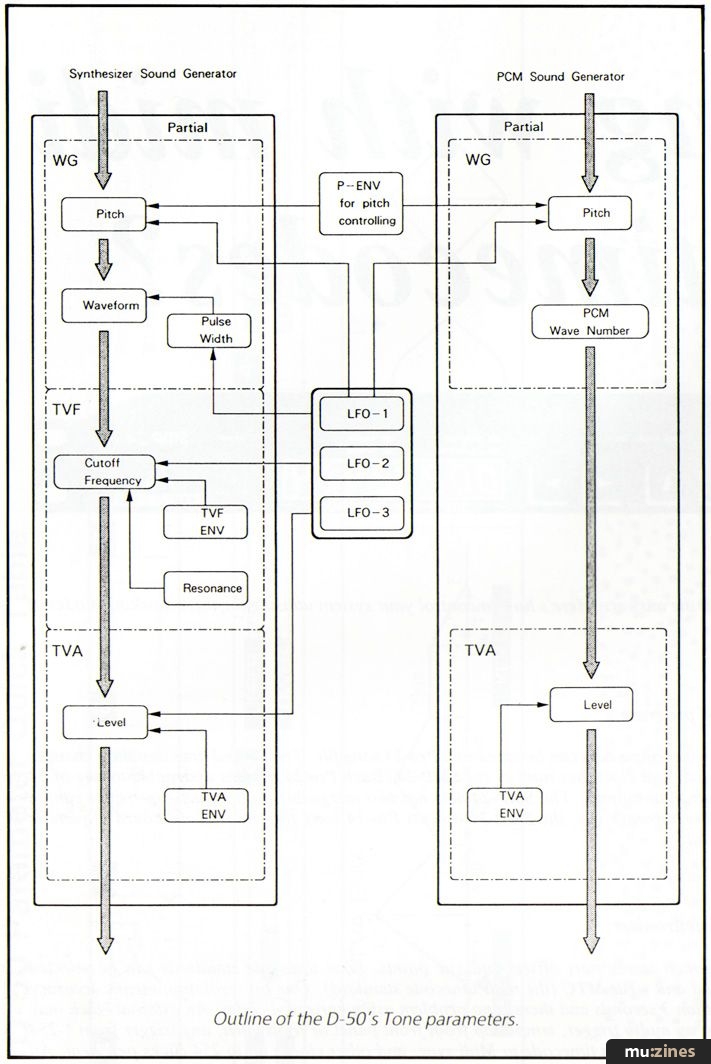
Outline of the D-50's Tone parameters.
LIFE BEFORE LA
Mr K: "About three years ago, we looked at what we had achieved with SAS, and decided to move on to a new method of synthesis..."
There has been a lot of confusion about SAS - Roland's Structured Adaptive Synthesis system. Its main application is in the generation of percussive sounds, but the reviews have been rather sparse on information about how it works. Mr Kakehashi responded to my probing questions by moving to a white-board and drawing a dismembered fish! He then used this diagram to explain how a sound can be made up of many different parts, and how changes in the size of just one part can change the appearance of the fish and thus the detail of the sound. The specification for a particular sound is thus contained in separate easy-to-manage bits.
Mr K: "Each system has its best part - SAS focuses on percussive sounds by concentrating on the details within the sounds... It is very good for synthesizing pianos, harpsichords - but we never expected brass-type sounds..."
With SAS, the required sound is split up into basic structural parts using Fourier Analysis techniques. The resulting spectra are then coded into waveshapes using additive synthesis of sine waves, and this is the shape which is stored. These fundamental sound building blocks are the Structures implied in the name. The Adaptive element of the name comes from the way that the parts are scaled and mixed together with respect to key velocity and time, and it is this which produces the extremely realistic simulation of percussive sounds possible with SAS.
Using the fish analogy, you can leave the size of the fish alone and change just the size of one of its fins! Because percussive sounds intrinsically do not sustain for very long, SAS can have a great deal of detail for each sound in a short time - and, therefore, in a small amount of memory space. It is very good for re-creating existing sounds, but offers no route to generating new ones.
SAS was Roland's first experiment with totally digital synthesis. Spurred on by its success, they looked at methods more suited to implementing full synthesizer facilities. SAS uses lots of ROM (Read Only Memory - whose contents are fixed forever and can only be read out) to store its Structure Definitions which control the reconstruction of the sounds. The hard work is in analysing the sounds and coding them in the ROMs. The large amounts of ROM used were cheap to buy and additive synthesis was relatively easy to do with the technology available two or three years ago. Yamaha's FM and Casio's PD systems offered similar benefits - both use a small amount of ROM, and a relatively simple amount of signal processing to produce the sounds. But there was the problem of editing, and Roland felt that non-linear techniques such as FM were rather limited...
Mr K: "Two years ago we started the chip design for LA..."
LA Synthesis represents a new direction for Roland. Rather than go for an FM/PD lookalike, they decided to use the principles of analogue synthesis by directly converting it to the digital domain, but also took the opportunity to add samples to widen the range of synthesis possibilities. The new software-based technology would need large amounts of RAM (read/write memory) and very fast signal processing, as opposed to the very small RAM requirements and simple processing of FM. They waited for the availability of the required chips and then designed a custom LSI gate array DSP - containing between 10 and 20 thousand logic gates. ('DSP' is an acronym for a Digital Signal Processing chip.)
Mr K: "The maximum speed of normal DSPs was not fast enough, so we designed our own... with access time to RAM minimised by having it on the same chip..."
Mr K: "There are only three manufacturers in Japan who have the ability to make a chip of this complexity..."
The DSP chip undertakes all the filter simulation as well as the multiplication for the waveshape convertor. It does this for the 32 separate sounds all at the same time - so it needs to be very fast and very accurate; the internal resolution is 28 bits (ie. well over twice the number of bits used in a 12-bit sampler!). To control the DSP chip a 16-bit microprocessor is used, and there is also the 4Mbit ROM containing the PCM (sampled) sounds. All in all, quite an impressive set of chips.
Mr K: "The DSP is a Fujitsu gate array; we have our own design team who deal with all the chip designs - we call it our 'bakery'..."
Mr K: "My engineers are very clever... my job is how to eliminate the superfluous parts of their designs - to know when to stop adding to a design..."
INSIDE A D-50
There is very little hardware inside a D-50. The main printed circuit board (PCB) is only about 220mm (9 inches) square and uses 'surface mount' - the latest technology for soldering components to PCBs. Most of the ICs are soldered onto the top of the PCB without the use of holes through it, and only a few components are conventionally mounted using through-hole placing. 'Surface mount' also enables much higher packing densities and thus reduces the board size.
On the main circuit board there are four 64-pin flat packs (Hitachi?), two Roland 32-pin DILs (the PCM ROMs?), some dynamic RAM (41416s) and some low power battery-backed static RAM (Hitachi 62256LPs). There is also an NEC 78312G CPU microprocessor running at 12MHz and an associated Fujitsu 64Kbyte System ROM (a 27C512 EPROM). Pride of place on the board is taken by the Fujitsu DSP chip - an 88-pin PGA (pin grid array) ceramic package just over an inch square, which runs at 32MHz. Clustered around a Burr-Brown PCM54 DAC (only 16 bits!) are a few miscellaneous CMOS and HC-type TTL gates, as well as a small amount of analogue output circuitry.
Mr K: "The special DSP and the 16-bit CPU produce very high speed processing.... the 16-bit bus helps speed up the operations..."
Mr K: "The fast RAM cache is on the DSP chip. There is also slower access time RAM for patch memory..."
The D-50's parameter display is excellent, using a Sharp LCD and OKI driver LSI chips. The main circuit board of the D-50 sits directly underneath the display, so when you gaze at the display you are actually looking towards the digital 'heart' of the D-50 synthesizer.
The keyboard itself is 'scanned' using another custom Roland 64-pin flat pack chip surface mounted (again!) on a small separate PCB underneath the keyboard. (A separate PCB suggests a keyboardless rackmounting version of the D-50 will be very simple to produce.) The few cables used to connect together the PCBs are all foil-screened to keep the RF emission down, and, in fact, all the metal parts of the case are earthed and some parts have additional copper foil screening. A steel box encloses a conventional linear (of course!) power supply. All in all, a very neat, tidy, thorough and completely up-to-date piece of design and construction - full marks Roland!
Mechanically, the D-50 has a steel chassis built around the keyboard frame, with a removable steel bottom plate. Most of the rest of the casing is made of anodised aluminium extrusion, in either a matt or bright finish. The only plastic parts are the end-cheeks, which cover steel plates underneath. Overall, an excellent standard of construction.
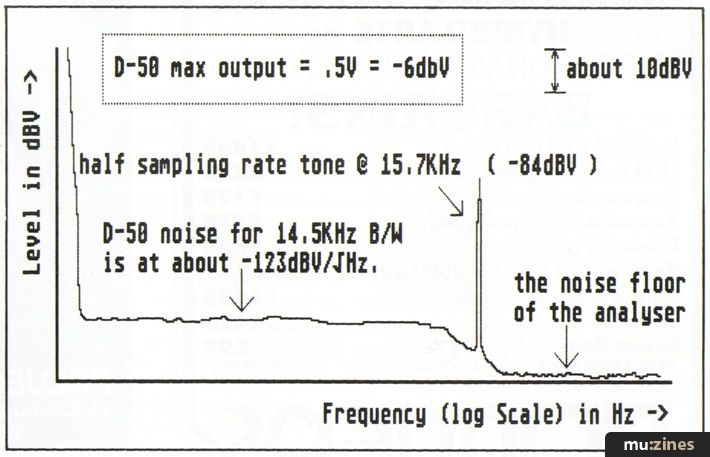
D-50 measured spectrum.
THE DAC
The advertising blurb for the Roland D-50 mentions a 20-bit Digital-to-Analogue Convertor (DAC). Inside, I found only a 16-bit CD player type of DAC, leaving a missing 4 bits. Closer examination of the PCB showed a few analogue components associated with the DAC, including some multiplexing chips suitable for use as scale changing for a DAC. This suggests that the D-50 uses a similar system to the Yamaha DX7, where things like output level and overall volume are handled not by the DAC itself, but by external circuitry, resulting in a wider dynamic range than the 16-bit accuracy would suggest. This is probably where the extra 4 bits in the specification are derived.
The D-50 still seemed to be noisier than my DX7 though, so I took some measurements using a spectrum analyser. It turns out that the basic signal-to-noise ratio of the D-50 is about 77dB, comparable with a DX7 (Mk I) but with a lower maximum output level than the DX7 - hence the apparent difference in noise levels. Even so, this is not anything like the 120dB ratio you would expect from a 20-bit DAC. (For the more technically minded, I took the level of the noise over the 15.7kHz bandwidth of the D-50 - the sampling frequency is 31.4kHz - and worked out the signal-to-noise ratio for the bandwidth, rather than the more straightforward method of just connecting a level meter to the output.)
Speaking of outputs, there is a half sampling frequency signal component in the output of the D-50 - 15.7kHz at about 70dB down on the maximum signal level (see diagram). There is some shelving low pass filtering as well to remove any higher frequency noise.
However, do not forget that we are talking here about a signal which already has digital chorus and reverb in it (the D-50 offers these as onboard effects remember), all created completely in the digital domain. To make a fair comparison, if I was to use a digital reverb unit on the output of my DX7 I would lose 6dB of signal-to-noise ratio because of the two extra stages needed to convert the signal from analogue to digital and back, and would end up with a much noisier signal! And the D-50 is already a stereo output, unlike the DX7. (But I am still waiting for a digital synth which gives me a 44.1 kHz, 16-bit CD style output so that I can go straight into a digital desk like the Yamaha DMP7...)
Mr K: "We do not feel the market is ready for digital outputs yet - remember that we do not need to add any effects to the D-50..."
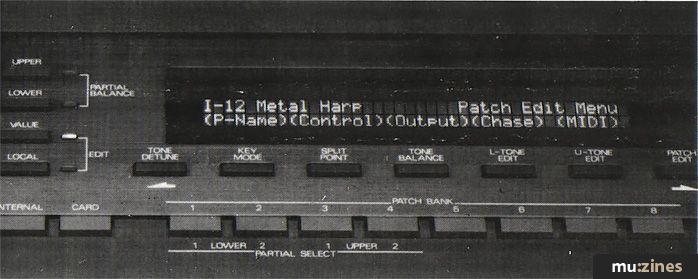
EDITING SOUNDS
So far we have seen what LA (Linear Arithmetic) Synthesis is, and how it works. I covered some of the sounds in last month's review of the D-50, so now I turn to editing. As a confirmed FM fan and programmer, I was very pleasantly surprised by the possibilities opened up by the D-50...
Mr K: "The ROM PCM samples are there to enhance the instrument - the synthesizer alone is very sophisticated, but if the sound is not quite enough then the ROM sounds can add the vital 'spark' to the sound..."
Absolutely. I initially used the PCM samples to liven up brass and string sounds. This is just a case of selecting an appropriate instrumental Tone on (say) the Upper Voice, and using the Lower Tone's Partials to examine the effect of various PCM samples and Structures. I did notice that I tended to prefer the 8-voice Dual mode for playing around with complex sounds, since it gives you four separate sounds. Even contrasting sounds have their part to play here - orchestral washes are improved remarkably by adding a few percussive timpani-type 'thumps' to their attack sections...
The D-50's Advanced manual is the main reference point for editing. One of its few omissions is a chart showing which parameters are available for editing PCM samples - several times I wondered why my PG-1000 (the D-50's optional programmer unit) knob-twiddling was not having any effect on the sound! To rectify this you should find a suitably marked D-50 patch sheet lurking somewhere around this text. It also serves as a good introduction to a talk-through of a Voice - 'Australian Desert' - created by my good self, which illustrates how the PCM samples on the D-50 can be used for more than just adding a bit of spice.
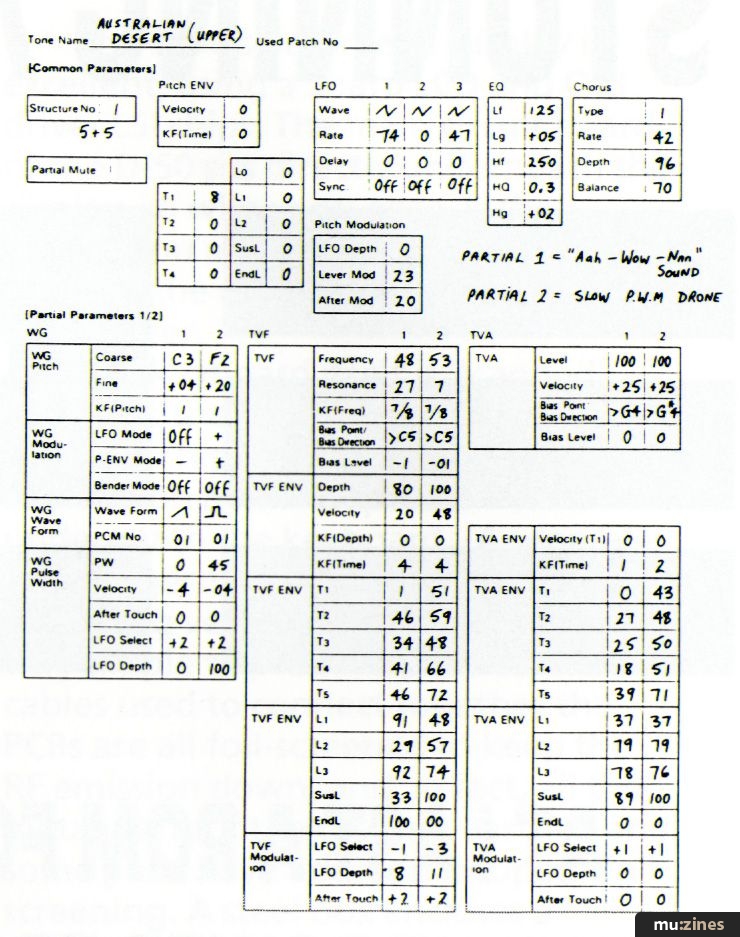
Upper and Lower Tone patch sheets for the author's D-50 example voice - 'Australian Desert'.
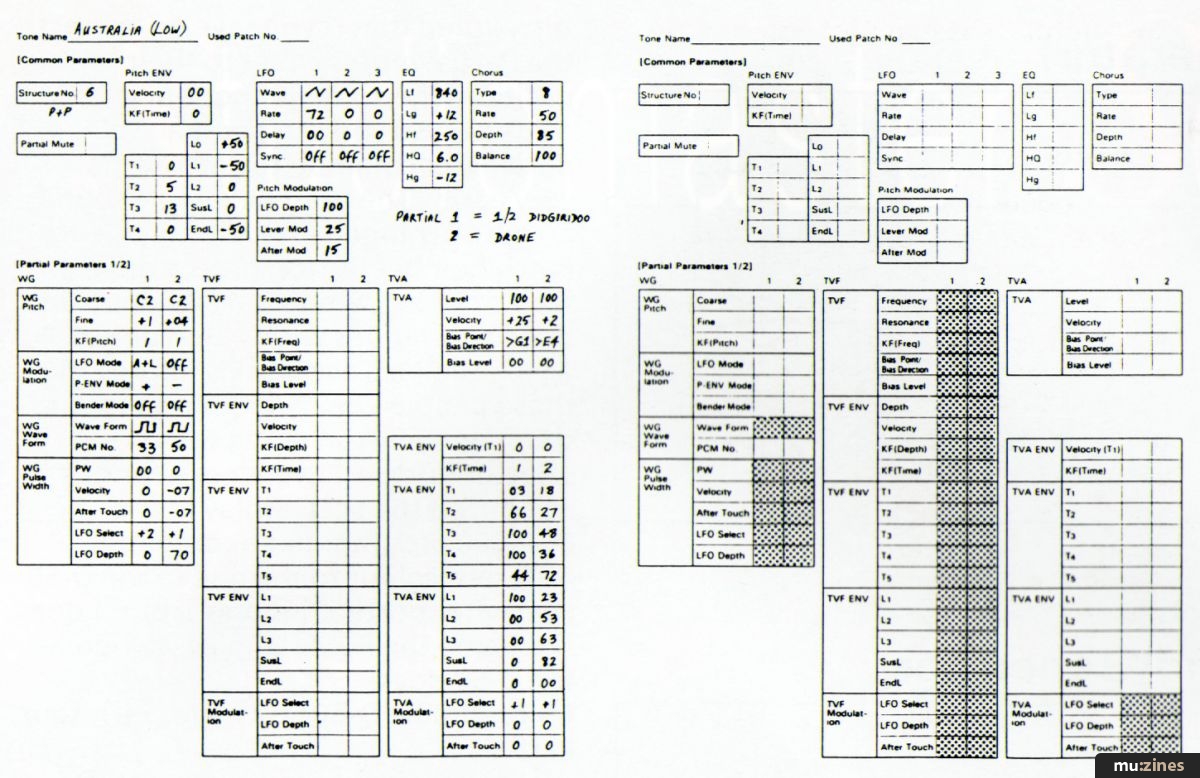
Upper and Lower Tone patch sheets for the author's D-50 example voice - 'Australian Desert'.
Those parameters shown as 'grey' are 'inactive' when using the D-50's PCM samples.
AUSTRALIAN DESERT
OK - this is an atmospheric, complex sound that shows off the sort of multilayered capability that the D-50 is very good at.
You start with some woody-sounding synthetic 'whumps' and then a didgeridoo type sound with a bit of drone, which is characterised by a drop in pitch followed by a rise up to the normal pitch and then down again on key release. Meanwhile, a sort of vocal 'aah' sound evolves through a 'wow' sound into a nasal, sustained 'nnn' sound, which is then joined by a droning pulse width modulated wash loitering in a reverberant landscape.
As is always the case when trying to describe 'sound' in words, each of the component parts does not sound overly spectacular in itself, but the combined array of sounds gels together into an awesome event.
In detail: the Upper Tone produces the vocal sound and the slow PWM drone, using Structure 1 (two synthesizer Partials). No pitch envelope based pitch variation is used, and the individual sounds are just classical analogue derivations from my mind's library, altered to make full use of the available 5 stage/10 parameter envelopes (and some use of aftertouch and velocity). A lot of chorus is added to give the washes a suitably mushy feel.
The Lower Tone is lots more fun, using an 'Up then Down, then Up to hold, then Down' type pitch envelope to liven up the PCM samples. Structure 6 gives two samples: here I used No.33 - 'Steamer' - for the didgeridoo sound, and No.59 - the 'Electric Guitar' loop - for part of the drone and the thump. I used the D-50's 'Dimension' setting for the chorus to open out the samples at first, and then removed it, but you can always edit it back in...
The mix between the two Tones is about even, and I used Reverb No.4 preset ('Chapel'), at a lowish level, to just add a bit of space to the Voice. For showing off in performance, the Chase mode is set to give a long succession of repeats. Looking at the accompanying patch sheet may be a bit daunting, but when you are actually doing the editing the parameters seem nothing like as numerous.
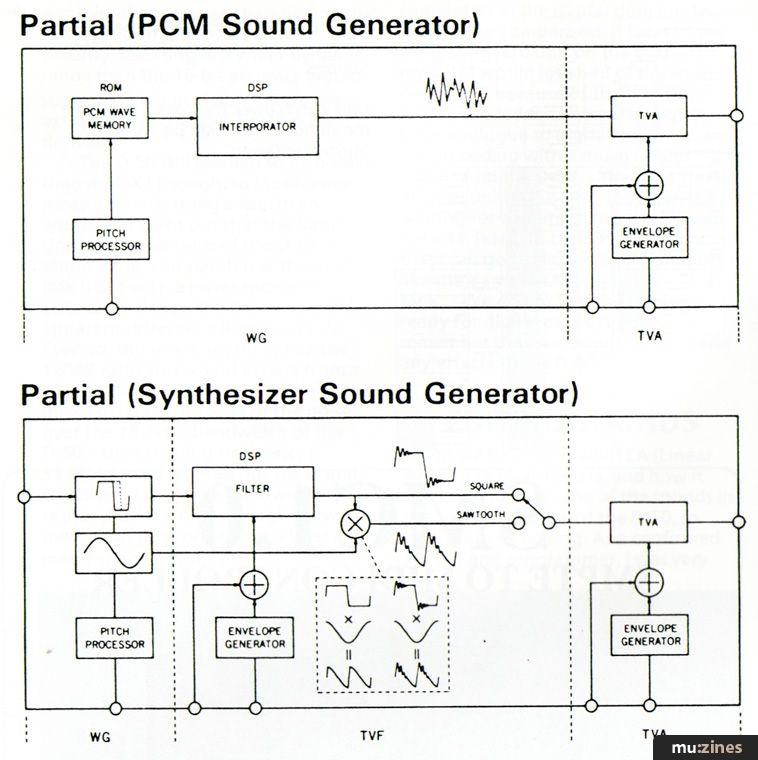
Partial (PCM Sound Generator)
Partial (Synthesizer Sound Generator)
Mr K: "In Japan, I invited the Press people to a demonstration of the D-50. Everyone tried to guess the price - they put it at about 30% higher than the DX7 MkII with floppy disk... the D-50 costs much less!"
When editing, the D-50 scores in lots of ways. The easy switching on and off of Partials enables you to switch contexts, and the fact that the display shows all related parameters is very good for enabling meaningful edits of envelopes, etc. The idea of using left and right scroll buttons to move between pages of parameters is rather useful, and much better than having to keep finding buttons to choose a new section. I found that it was wise to leave a memory location free to use as a scratch-pad, for storing a Voice whilst editing it, as I lost a few sounds by 'comparing' and being unable to retrieve the edited version. Experience soon cured this, although I am unsure as to why 'Compare' returns you to the Patch Edit level, rather than back to where you were editing.
Mr K: "Even without the PG-1000 programmer, the large display means that you can easily create your own sounds"
Roland have traditionally placed a lot of emphasis on the programming of your own sounds. One of the first instruction books I ever saw on analogue synthesis was included with one of their synthesizers, and the D-50 seems to positively invite you to edit its sounds.
You may start off just editing the reverb type for a patch, or perhaps the Tone balance, but this quickly leads you into listening to the Tones, and perhaps altering the chorus common to two Partials. Once you have looked at the Partials you invariably want to tweak a parameter here and there... and before you know it, you're editing! The dividing line between the editing of sounds and the creation of new patches on the D-50 is very diffuse - very unlike a DX where some people never touch the purple 'Edit' button.
Mr K: "Once you have started using the display, you find you are editing sounds..."
Mr K: "We designed it for people with eight fingers (and two thumbs, of course!) - so there is no MIDI overflow..."
As always with complex instruments there are a few traps for the unwary. Swallowing my patented Sound On Sound 'Instant Naivety' pill, I discovered that if you save a Tone with the Partial mutes all set to their 'off' position, then you get no sound output! Also you can't edit a parameter common to each Partial very easily. The preset example sounds are also arranged interestingly - each Patch number button gives a different type of sound, while the Bank button selects variations within that genre. A very good idea for quickly impressing those people who wander into music shops and idly run along the preset selector buttons! Even more curious - not only is the LCD display in the PG-1000 programmer a completely different colour to the one in the D-50 (the wife spotted this one!), but it does not name the PCM samples - whereas the D-50 does!
Mr K: "In the D-50 you have... err, four Partials..."
A very interesting comment! Do you get eight Partials in the D-100? And what about a rack-mounting keyboardless version? And how about replacing the PCM ROM with RAM for DIY sampling? That's probably enough teaser questions for one month!
SOUNDS LIKE...
In reviewing the D-50 I was faintly reminded of the old ARP Quadra (remember that?), mainly because of the layering facilities, and the examples chosen reflect the D-50's power in this field. Although all this synthesizing power should make accurate imitations of sounds possible, there are very few examples of this in the presets supplied with the D-50. It would be a very brave (and foolish) reviewer who would dismiss the D-50 with comments like those which appeared in the early reviews of the original DX7 and which limited the DX7's possible sounds to thin, percussive imitations. Instead, I will assume that we have been given a 'market driven' set of fashionable sounds, and certainly from my own editing experiences the limits to the D-50's range were difficult to probe in the restricted time available.
As with all 'classic' synthesizers, the D-50 had a 'quality' to its sounds which was all its own. This is not really the instrument to replace all others, rather another powerful ally to add to your existing set-up - just as the opening quote from Mr Kakehashi indicates!
Mr K: "I think today's synthesizers make good sounds, but for the future we must create new timbres - that is our aim... We Design the Future!"
I would like to thank Mr Ikutaro Kakehashi, Brian Nunney, Alan Townsend and all at Roland for their help, patience and time.
The D-50 retails for £1445 and the PG-1000 for £320, both including VAT.
You can contact the future at: Roland UK Ltd, (Contact Details).
Series - "Roland D-50"
This is the last part in this series. The first article in this series is:
Roland D-50
(SOS May 87)
All parts in this series:
Part 1 | Part 2 (Viewing)
More with this artist
Also featuring gear in this article
Roland D50
(MM Aug 87)
Roland D50 Synthesiser (Part 2)
(MT Jun 87)
Patchwork
(MT Sep 87)
Patchwork
(MT Dec 87)
Patchwork
(MT May 88)
Patchwork
(MT Jul 88)
Patchwork
(MT Sep 88)
Patchwork
(MT Jan 89)
Patchwork
(MT Feb 89)
Patchwork
(MT Mar 89)
Patchwork
(MT Apr 89)

Patchwork - PA DECODER D50 ROM Vol III
(MT Jun 90)

Patchwork
(MT Oct 90)

Patchwork - VALHALA D50 Sound Cards
(MT Nov 90)
...and 11 more Patchwork articles... (Show these)
Browse category: Synthesizer > Roland
Featuring related gear
Musictronics MEX D50/D550 Expansion
(MT Feb 90)
Browse category: Software: Editor/Librarian > MIDImouse
Browse category: Expansion Board > Musitronics
Publisher: Sound On Sound - SOS Publications Ltd.
The contents of this magazine are re-published here with the kind permission of SOS Publications Ltd.
The current copyright owner/s of this content may differ from the originally published copyright notice.
More details on copyright ownership...
Artist:
Ikutaro Kakehashi
Role:
Company Founder
Series:
Roland D-50
Part 1 | Part 2 (Viewing)
Gear in this article:
Synthesizer > Roland > D50
Gear Tags:
Review by Martin Russ
Help Support The Things You Love
mu:zines is the result of thousands of hours of effort, and will require many thousands more going forward to reach our goals of getting all this content online.
If you value this resource, you can support this project - it really helps!
Donations for November 2025
Issues donated this month: 0
New issues that have been donated or scanned for us this month.
Funds donated this month: £0.00
All donations and support are gratefully appreciated - thank you.
Magazines Needed - Can You Help?
Do you have any of these magazine issues?
If so, and you can donate, lend or scan them to help complete our archive, please get in touch via the Contribute page - thanks!







